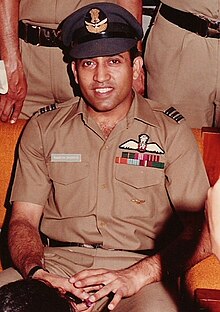Rakesh Sharma
Rakesh Sharma | |
|---|---|
 Rakesh Sharma | |
| Born | 13 January 1949 |
| Status | Retired |
| Nationality | Indian |
| Occupation | Test pilot |
| Awards | File:Golden Star medal 473.jpg Hero of the Soviet Union |
| Space career | |
| Rank | |
| Missions | Soyuz T-11 / Soyuz T-10 |
Mission insignia | |
Rakesh Sharma, AC, Hero of the Soviet Union, (born 13 January 1949) is a former Indian Air Force pilot who flew aboard Soyuz T-11, launched April 2, 1984, as part of the Intercosmos programme. Sharma was the first Indian to a travel in space.[1][2]
Early life
Rakesh Sharma was born on 13 January 1949 in Patiala, Punjab, India. He attended St. Georges Grammar School, Hyderabad. He graduated from Nizam College. He joined the Air Force as a cadet in 1966 at the age of 18. Thereafter, he was admitted to the National Defense Academy as an Air Force plebe in July 1966. Rakesh proved to be a focused and dedicated student and by 1970, he was commissioned into the Indian Air Force to become a pilot.
Career
An alumnus of the 35th National Defence Academy, Rakesh Sharma joined as a test pilot in the Indian Air Force in 1970. He flew various Mikoyan-Gurevich (MiG) aircraft starting from 1971. Rakesh Sharma swiftly progressed through many levels and in 1984 he was appointed as the Squadron Leader and pilot of the Indian Air Force.[3] He was selected on the twentieth of September in 1982 to become a cosmonaut and go into space as part of a joint programme between the Indian Space Research Organisation (ISRO) and the Soviet Intercosmos space program.[4]
He retired with the rank of Wing Commander. He joined the Hindustan Aeronautics Limited in 1987 and served as Chief Test Pilot in the HAL Nashik Division until 1992, before moving on to Bangalore to work as the Chief Test Pilot of HAL. He was also associated with the Light Combat Aircraft Tejas.[4]
Spaceflight
In 1984, he became the first citizen of India to go into space when he flew aboard the Soviet rocket Soyuz T-11 blasted off from Baikonur Cosmodrome in Kazakh Soviet Socialist Republic on the second of April 1984. The Soyuz T-11 docked and transferred the three member Soviet-Indian international crew which also included the Ship's Commander Yury Malyshev and Flight Engineer Gennadi Strekalov (USSR) to the Salyut 7 Orbital Station. He spent 7 days 21 hours and 40 minutes aboard the Salyut 7 during which his team conducted scientific and technical studies which included 43 experimental sessions. His work was mainly in the fields of bio-medicine and remote sensing.[4] The crew held a joint television news conference with officials in Moscow and then Indian Prime Minister Indira Gandhi. When Indira Gandhi asked Sharma how India looked from outer space, he replied Saare Jahan Se Achcha (the best in the world). This is the title of a patriotic poem by Iqbal that had been written when India was under British colonial rule, and continues to be popular today. India became the 14th nation to send a man to outer space.[4]
Awards
He was conferred with the honour of Hero of Soviet Union upon his return from space. The Government of India conferred its highest gallantry award (during peace time), the Ashoka Chakra on him and the other two Soviet members of his mission, Malyshev and Strekalov.[4]
Personal life
He and his wife Madhu learned Russian during their stay in Russia in 1982. His son Kapil is a film director and his daughter Kritika is a media artist.
See also
References
- ^ "Cosmonaut Biography: Rakesh Sharma". Spacefacts.de. Retrieved 6 July 2012.
- ^ "Rakesh Sharma". Mapsofindia.com. Retrieved 6 July 2012.
- ^ "Rakesh Sharma". aerospaceguide.net. Retrieved 4 June 2014.
- ^ a b c d e Srinivasan, Pankaja (4 April 2010). "The down to earth Rakesh Sharma". The Hindu. Retrieved 5 April 2014.
External links
- Indian astronauts
- Indian aviators
- Space programme of India
- Foreign Heroes of the Soviet Union
- Indian Air Force officers
- 1949 births
- Living people
- People from Hyderabad, India
- People from Patiala
- Osmania University alumni
- Punjabi people
- Recipients of the Order of Lenin
- Recipients of the Medal "For Merit in Space Exploration"

